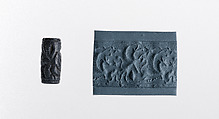Cylinder seal and modern impression: winged griffin attacking seated winged bull
Not on view
Although engraved stones had been used as early as the seventh millennium B.C. to stamp impressions in clay, the invention in the fourth millennium B.C. of carved cylinders that could be rolled over clay allowed the development of more complex seal designs. These cylinder seals, first used in Mesopotamia, served as a mark of ownership or identification. Seals were either impressed on lumps of clay that were used to close jars, doors, and baskets, or they were rolled onto clay tablets that recorded information about commercial or legal transactions. The seals were often made of precious stones. Protective properties may have been ascribed to both the material itself and the carved designs. Seals are important to the study of ancient Near Eastern art because many examples survive from every period and can, therefore, help to define chronological phases. Often preserving imagery no longer extant in any other medium, they serve as a visual chronicle of style and iconography.
This cylinder seal is made of bitumen. The modern impression of the seal is shown so that the entire design can be seen. The image shows a winged griffin attacking a seated winged bull. Several other elements, including possibly a fish, a star and a monkey, surround the scene.
The rendering of the creatures on this seal, as well as the deep, gouged style of the carving, is comparable to Neo-Elamite seals from Susa and Choga Zanbil, suggesting a date between the 9th and the 6th century B.C.
This seal was excavated at Surkh Dum, a settlement site in Luristan in the Zagros Mountains of western Iran. It was found in a structure interpreted as a sanctuary and was thus probably an offering to a god.
Due to rights restrictions, this image cannot be enlarged, viewed at full screen, or downloaded.

